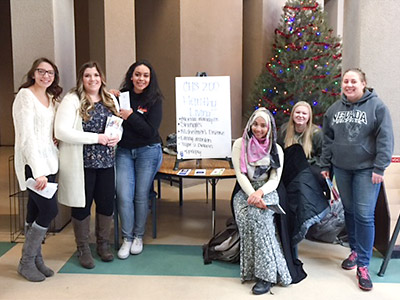
Community Health Science students present their work and brochures about a chosen topic to the TMCC community in December, setting up easels in common areas.
As part of their semester of study on public health issues, Community Health Science (CHS) students fittingly presented the results of their research in public, at open and commons areas of the College.
On Monday, Dec. 12, CHS 200: Introduction to Public Health Biology students set up information tables in shared areas and atriums of Truckee Meadows Community College. Class members presented the brochures they created with the results of their study. Their goal was to offer information in an accessible way for anyone in the college community to easily grasp and learn a little more about their chosen topic.
“The students chose their disease topic and they submitted a peer-reviewed scientific research study about it earlier in the semester,” said Laura Briggs, PhD, CHS Instructor. “While they were working on their brochures, we used a class day to go over their first draft with each other and critique work in progress.”
She said that after the class critique, they worked on it some more along with receiving additional feedback from her before finalizing the brochures.
“Choosing their own topic makes it meaningful and personal for the class,” she added.
During this semester and the past few terms; diabetes, eating disorders and exercise have been popular topic choices because most students have had experience with these directly or through networks of family members and friends.
“Chronic diseases, such as cardiovascular disease, cancer, diabetes and respiratory disease are now the major cause of death and disability,” Dr. Briggs said.
Chronic illness now causes more deaths globally instead of infectious disease.
“Noncommunicable diseases were responsible for 68 percent of all deaths globally in 2012, up from 60 percent in 2000,” according to the World Health Organization (WHO). “The 4 main NCDs are cardiovascular diseases, cancers, diabetes and chronic lung diseases. Communicable, maternal, neonatal and nutrition conditions collectively were responsible for 23 percent of global deaths, and injuries caused nine percent of all deaths.”
For the Fall projects, the students presented their study of infectious and chronic public health issues including the following:
- Alzheimer’s disease
- Bacterial meningitis
- Breast cancer
- Epilepsy
- Human immunodeficiency virus (HIV)
- Lupus
- Osteoporosis
- Shingles
- Type 2 Diabetes
- and others
CHS Students Speak
Logan DiNapoli, who will graduate in May with an Associate of Science degree, plans to transfer to the University of Nevada, Reno.
“Community Health Science is multifaceted; it touches social issues, environmental issues, public health of course, and general health, wellness and education,” he said. “We have so many issues regarding our health and wellness these days. I attribute this to lack of education and prevention measures. Sugar is the root cause of a lot of our illnesses, in fast food and processed food. Even healthy fruit has sugar.”
Although DiNapoli is passionate about teaching sugar’s role in inflammation and some chronic illnesses, he chose instead to do his semester project on Lupus, an autoimmune disease. Specifically, his project concerned Systemic lupus erythematosus (SLE), a chronic disease for which the cause is not yet known—although genetics, estrogen and environment have seemed to play a role.
“Lupus takes a long time to diagnose properly,” he said. “It’s an autoimmune disease that can affect many systems of your body.”
A classmate, Alexa Dimas, completed her project on the topic of breast cancer.
“It’s sometimes hereditary and protection does include self-exams, even to the armpits,” she said. “Prevention includes a diet with the omega fatty acids found in fish—staying away from processed foods is good. There are trans fatty acids in some processed food that can expedite the process of cancer.”
Evan Kerns and Sam Garcia conducted their project research on chronic diseases that sometimes come with aging.
“I’ve been working in the Alzheimer's disease industry, in assisted living and memory care, for seven years as a marketing and sales counselor,” Garcia said. “I help people move into the community and know more about the disease. We need more people who are willing to volunteer or work as a caregiver."
Kerns said that osteoporosis is more prevalent than most people know, causing a disease-related fracture in 20 percent of men and half of all women in the U.S. over the age of 50.
“It causes fractures in the spine, wrist and hip,” he said. “Calcium and vitamin D are good for bone health, as is regular physical activity. Avoid dangerous activities like dirt biking without a helmet, smoking and excessive alcohol. You can take classes to know the risks and there are several FDA-approved medications for people who already have fractures to prevent additional fractures.”
Occupational Outlook for CHS Majors
“Job outlook is good for CHS majors and opportunities are expected to increase,” Briggs said. “As our population ages I expect we'll see an increased demand for public health workers, particularly in the health care field.”
For more information about studying Community Health Science, contact the Biology Department at 775-673-8251.






